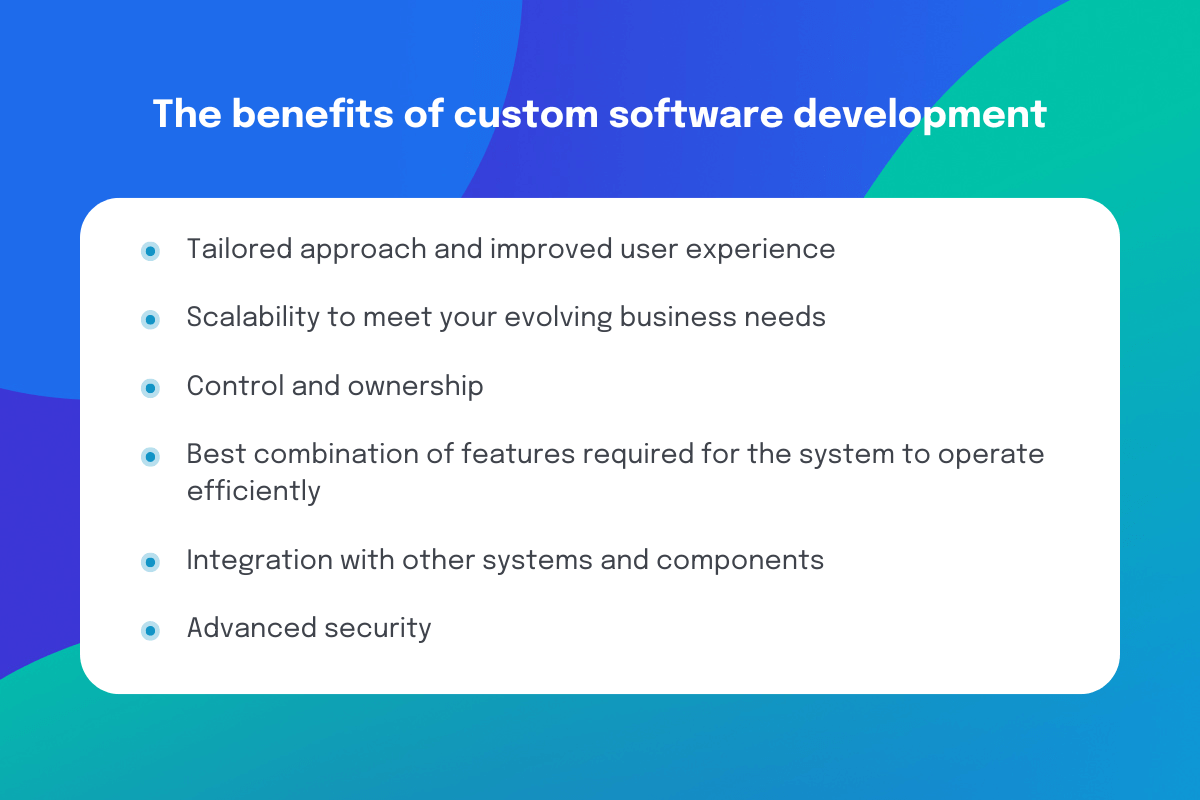Custom software development is the art of designing and building software solutions that cater specifically to your business needs. Unlike generic, off-the-shelf products, custom solutions adapt to you, rather than forcing you to adapt to them. These tailor-made applications are built from the ground up with your specific goals and objectives in mind, ensuring seamless integration and rapid data exchange with other business systems.
This article explores why companies opt for custom development, the benefits it offers, how to estimate the costs of building custom software, and how to choose the right development partner.
Table of Contents
Defining custom software development
Essentially, a custom-developed solution:
- Is built to meet specific business requirements and standards.
- Can be modified and upgraded as the business evolves.
- Can be seamlessly integrated into the existing business ecosystem.
Organizations hire software development teams to design and create custom software when they need unique features and functionality that reflect specific business needs and want to retain ownership of the developed software.
The question is whether a company needs to build software from scratch or should use prebuilt, off-the-shelf solutions. This decision depends on the business requirements and the vision for how scalable and adjustable the applications need to be.
For example, the booking systems used in various barbershops are off-the-shelf solutions. Barbershops purchase these ready-made products because they are less expensive than creating a unique reservation system from scratch. They are satisfied with such systems because they can customize the branding and basic functionality to meet their specific needs, and these solutions can be quickly integrated into their websites.
In contrast, financial businesses use tailor-made solutions to maintain full control and ensure the security of their digital transactions. Large tech companies create custom software to achieve the highest performance and ensure seamless integration with their existing infrastructure.
We will explore in more detail the use cases for building custom software versus buying off-the-shelf solutions later in the article.
The benefits of developing custom software
Custom software development offers companies an improved user experience, seamless integration with existing software systems, scalability, and complete ownership and control over all software components.
Tailored approach and improved user experience
Custom software development involves direct dialogue between your development team and the users of your software product, whether they are your customers or internal team members. User requests for desired functionality and feedback are presented directly to your development team, making an improved user experience the focus.
In contrast, when you buy off-the-shelf software from a vendor, your company becomes just one of many users with common needs. The collective demands of all these companies influence the vendor’s priority in releasing certain product features. However, modern commercial off-the-shelf software often comes with application programming interfaces (APIs) that allow certain customizations without the need to access the source code of the core product.
Scalability
Custom software allows your business to grow without limitations by letting you modify its features to suit your specific needs at any stage of development. By comparison, off-the-shelf solutions often come with fixed licenses and predetermined functionalities, and their improvement is closely dependent on the software provider’s plans.
Control and ownership
Custom software development ensures full ownership of the product and control over all its components. You can add new features or switch to a different technology stack whenever you need to.
Documenting each phase of development in chronological order strengthens ownership and helps avoid disputes between similar products by providing clear evidence of the product’s creation and modification history.
However, today’s software often raises questions about ownership because it is rarely created by a single party. Software development teams frequently use third-party libraries and frameworks to enhance functionality. Each of these modules comes with its own set of licenses, which can affect the proprietary nature of your software.
Optimal set of features
While commercial software provides companies with a predefined set of features, custom software can include a tailored set of components, and more importantly, only those that are necessary for the system to work effectively. This means the feature set is optimized for the needs of a particular business, and your developers can always add new updates during the post-production phase.
Seamless integration
Ready-made solutions can’t provide full compatibility with your business systems. In contrast, custom development is designed to connect business flows and databases across all departments. Custom integrations improve data flow across systems, allowing internal teams to access and collaborate on information in real time.
Advanced security
Companies, from small online marketplaces to financial institutions and government agencies, deal with highly sensitive user data, including personal, financial, and confidential information.
Custom software solutions can be developed to address specific security threats and vulnerabilities unique to an organization’s operations, reducing the risk of data breaches. Custom development also eliminates dependence on third-party vendors, which can pose a security risk if their compliance and security standards are not reliable.
Continuous support and maintenance
Custom development involves continuous support and maintenance from your dedicated development team. They have virtually unlimited opportunities to modify custom software, including fixing bugs, adding new features, and optimizing or redesigning existing code.
This level of personalized attention typically doesn’t exist with off-the-shelf solutions, where you must wait for the product vendor to fix issues or provide updates. In the most extreme situation, if the vendor stops supporting the product, you may even have to switch to another software.
Custom software solutions vs. out-of-the-box software
| Custom software | Off-the-shelf software | |
| Development approach | Your internal or outsourced development team handles every stage of development and ongoing support | Available immediately. The software vendor handles continuous support and development |
| Customization | Full customization according to specific business needs | Predefined features and functionalities suited for a broad audience |
| Security | Designed to address specific security threats and vulnerabilities unique to an organization’s operations | Designed to address common threats and vulnerabilities faced by a wide range of users. In addition, because many organizations use the same off-the-shelf software, vulnerabilities in these systems can be widely known and targeted by attackers |
| Integration capabilities | Can be designed to connect business flows across all of your systems | Integration with existing systems can be difficult, if not impossible |
The distinctive advantage of out-of-the-box software is that it is already made, and further development and support are the software vendor’s responsibility. In addition, due to the large user base, the vendor heavily invests in security measures and compliance with regulatory standards like GDPR and HIPAA.
However, because many companies use the same commercial software, vulnerabilities in these products can be widely known. If malicious actors discover a vulnerability, they can target many users simultaneously. Additionally, security measures in commercial applications and services are designed for a broad audience and may not follow the specific security standards of an individual organization.
Generally, off-the-shelf software is used by companies that have requirements similar to many others in their industry. Purchasing such products can be more cost-effective than developing from scratch. Here are some examples of companies using ready-made solutions:
- Small and medium-sized enterprises often use off-the-shelf software for accounting, customer relationship management (CRM), sales and marketing, and office productivity.
- Service industry: barbershops, nail salons and spa hotels use off-the-shelf booking systems for appointment scheduling.
- Retail businesses can use off-the-shelf point-of-sale (POS) systems and inventory management software.
- Schools and universities use ready-made virtual learning environments, library management software, productivity tools, and student information systems (SIS).
- Smaller healthcare providers might use ready-made electronic health record (EHR) systems, practice management software, and laboratory information management systems (LIMS).
When is custom software used?
You should consider building a custom product if your company meets at least some of these criteria:
- You run a highly specialized business that requires unique software with tailored functionality.
- You want to create an innovative product that is not yet available on the market.
- You need to integrate several existing software products used for different business functions.
- Your company has dynamic workflows and experiments a lot.
- You need to personalize your customer experience, but off-the-shelf software solutions don’t provide enough branding customization.
- Your company uses older systems that need to be modernized or completely re-engineered to improve their performance.
In other words, companies choose to build custom software if they need to layer and modify its functionality as their workflows and customer needs evolve, and integrate it into the existing business ecosystem. Here are some examples of companies opting for custom software development:
- Large enterprises with complex infrastructure often require custom software to manage their operations efficiently.
- Healthcare companies need custom software to manage electronic health records and appointments, and to enhance medical decisions with targeted clinical knowledge and patient information.
- Banks and financial companies require custom solutions to manage customer accounts and transactions, ensure secure payment processing, identify financial risks, and monitor malicious activities.
- Retail and ecommerce businesses can build custom software to manage stock replenishment, track customer purchase history, and analyze customer behavior and sales data.
- Manufacturing companies use custom software to create detailed production plans, manage inventory, optimize supply chains, and identify defective products in real time.
- In the travel and tourism industry, companies build custom solutions to efficiently plan travel, manage bookings, and extract real-time information on flights and weather.
- Logistics companies use custom software to manage storage space, process orders, locate products, and improve communication along the supply chain.
- Custom telecom software improves service delivery by adopting cloud infrastructure and optimizing operational processes across network components.
- In the real estate industry, custom software assists with property inspections, evaluations, risk analysis, and mortgage processing.
- Government organizations build custom systems for managing tax filing, public administration, land registry, and building permits.
Browse 500+ Dev Teams Available for Hire
Best practices for building a custom software solution
Step 1: Research your business industry
Delve deep into your target audience’s demographics, preferences, and hidden desires. Research the competition, the technology they use to build their products, their pricing models, and their most unique features. Brainstorm ideas to determine what makes your software different from the competition.
Step 2: Define the project goals and requirements
Prepare detailed documents for project planning and execution that include objectives, methods, tools, and frameworks to be used. These documents should also define the desired set of skills and experience your custom software development team will need. In addition, the company’s technical lead and hiring managers should define performance-based requirements to set clear expectations for your software engineers.
The more specific you are about what you want to build, the better the software team will understand your business goals, leading to better results.
Step 3: Determine the budget
Evaluate the size and complexity of each software module you’re going to build based on data processing requirements, third-party systems integration, and the number of user interactions. Estimate the software development effort by consulting experienced engineers or project managers or by comparing it with similar projects you’ve completed in the past.
Identify the number of professionals to be hired for your project and their rates or salaries. Consider the commission of the hiring platform or outsourcing vendor in case of hiring an offshore development team, or recruiting and administrative costs in case of hiring in-house.
How to estimate custom software development costs?
Besides consulting with experienced software engineers, project managers, and industry leaders, companies also use estimation methods based on historical data and mathematical equations. We’ll explore three approaches for calculating custom development costs.
You can also request a cost estimate from a custom development company. Agencies that specialize in a particular niche will understand your requirements and can calculate a budget based on similar projects they have completed.
Top-down estimation
Top-down estimation is a high-level cost estimation method based on similar projects. This methodology does not require detailed information or careful analysis from the outset; rather, it relies on the opinions of experienced managers and data from past projects to quickly assess potential opportunities.
Technical leads calculate the budget as a whole and then break the development project into smaller components. They present their calculations to software engineers, designers, architects, and QA experts, who are likely to have a better understanding of how to implement the required tasks and, therefore, can estimate costs and development time more accurately.
Top-down estimation is best suited for recurring projects and work that needs to be completed urgently.
Bottom-up estimation
Bottom-up estimating is ideal for unique projects that differ significantly from anything the team has done before, making it difficult to estimate the scope of work from the get-go.
In this method, the team estimates the cost of each component or module individually and then sums these estimates to determine the total project cost.
Bottom-up estimation requires a clear understanding of all aspects of the project at the smallest level, making it the most accurate method. It considers all available resources and potential bottlenecks, as well as how they can be strategically overcome.
However, this methodology is time-consuming. It can take weeks or even months to gather complete information, making it unsuitable for teams with a heavy workload or limited human resources.
Parametric estimation
Parametric estimating relies on mathematical models to estimate costs based on project parameters. Each parameter (such as use case points, number of forms, number of user roles, database complexity, and performance requirements) is correlated to cost or time, and this correlation is scaled to the size of the project.
Each parameter requires a set of historical data, which can be obtained from previous projects, publicly available research, or agencies that provide benchmarking statistics.
Parametric estimation can produce two types of results. The deterministic result is the amount of required cost or time calculated based on parametric scaling. This amount can be adjusted manually to account for differences between the current and previous projects (e.g., different levels of team experience) or to add a time margin for unforeseen circumstances.
The probabilistic result involves calculating pessimistic, optimistic, and most likely estimates of the cost and duration of work, which can be converted into a final estimate using statistical formulas.
What are common criteria for calculating custom software development costs?
- Write down all the required features and define the complexity of each.
- List the programming languages, frameworks, and tools to be used. Consider the availability and cost of developers experienced in a specific technology.
- Estimate the number of components and evaluate the complexity of algorithms, databases, and user interactions.
- Define the number of software engineers and QA professionals required for the project, their seniority level, salaries, and rates.
- Break down the custom software development process into stages, such as design, implementation, testing, and deployment.
- List external software systems or APIs that need to be integrated.
- Calculate the cost of project management, administrative tasks, and documentation, as well as any software required for team management and communication.
- Estimate the cost for quality assurance.
- Consider the cost of possible product updates, security patches, and ongoing support.
How to choose a custom software development company?
After completing detailed project documentation, evaluating the complexity of your software, and determining the number of tech professionals and their required experience level, it’s time to hire your ideal development team.
In this section, we’ll discuss hiring a remote team from a global hiring partner or an outsourcing agency. Regardless of the hiring option you choose, it works best if your company has a CTO or VP of Engineering who can schedule daily standups and oversee the development process. A technical person with thorough experience can notice even subtle changes in performance and code quality, making it significantly more challenging for an external provider to sell them an underperforming engineer.
Step 1: Explore locations for hiring custom software developers
Choose a country for hiring a custom development team by investigating the region’s talent quality and experience, cost-effectiveness, time zone overlap, language skills, political stability, and compliance standards.
Regions like Latin America and Eastern Europe are commonly considered the most promising destinations due to a growing number of software development contracts and strong tech communities. Engineers from popular outsourcing locations such as Mexico, Argentina, Ukraine, and the Czech Republic often offer significantly lower rates than their U.S. counterparts. These developers have extensive experience in building products for U.S. companies, even if indirectly through their work at agencies.
You can collaborate with local or global hiring partners and marketplaces that are familiar with reliable software vendors and legal regulations in specific territories.
Step 2: Choose the right custom software development partner
You can visit review websites such as G2 and Clutch to look for top custom development providers, or you can choose YouTeam to access hundreds of vetted custom software agencies. You can also search for software development companies on LinkedIn by filtering location and industry, or attend tech conferences to meet developers in person.
Before signing a contract with a custom development company, focus on their portfolio, industry knowledge, and client reviews. Check whether the development company follows security standards and contractual agreements on intellectual property transfer and data protection.
Ensure that the software provider follows best design and development practices and can build reliable systems that verify identity, protect user data, and secure information exchanged within the app.
In addition, keep in mind that custom solution development companies in certain industries need to have specific certifications. For example, healthcare software developers should be HIPAA certified and follow interoperability standards like HL7, ICD-9, ICD-10, and CCR.
After reviewing these criteria, you’ll narrow down the shortlist of the most suitable custom software development companies.
Step 3: Discuss the budget with the development partner
Lower development rates can be attractive at first glance. However, some agencies may start with lower rates only to increase the budget later. The longer you work with a development agency, the more you depend on it, and the more expensive it will be to replace it. Therefore, if you see custom development rates significantly lower than the market without an obvious reason, consider it a warning sign.
Step 4: Protect your data and intellectual property
It’s crucial to control access to remote development team accounts to prevent sensitive information from falling into the hands of competitors or malicious actors. You should also sign a non-disclosure agreement before starting cooperation with a custom development provider.
Frequently asked questions
Why hire a custom software development company?
Custom software development companies typically have pre-screened engineers who have the experience needed for your project. In addition, these companies employ internal recruiters to find the best talent on the market. Hiring software engineers from external providers can give you access to niche skills that may not be readily available locally. In addition, outsourcing companies have well-established quality assurance policies and procedures.
Finally, outsourcing is more flexible than in-house recruitment. You can hire the required skills only for the duration of the development if the company does not need this expertise after the project is completed.
How to find a custom software development company?
You can visit review aggregators such as G2 and Clutch to find top custom development providers, or you can use marketplaces like YouTeam to access hundreds of vetted custom software companies. Alternatively, you can search for custom software providers on LinkedIn by filtering location and industry, or attend tech conferences to meet developers in person.
Common mistakes to avoid in custom software development
Poor communication, inadequate planning, and spiraling costs are some of the most common problems that can befall a company during custom software development. The key to overcoming these challenges is to create a clear and consistent development plan, schedule regular reviews, and strictly map out all the essential parts of the software and the “good to add” extras that can be removed if development costs increase dramatically.









